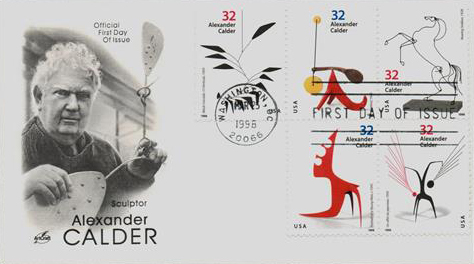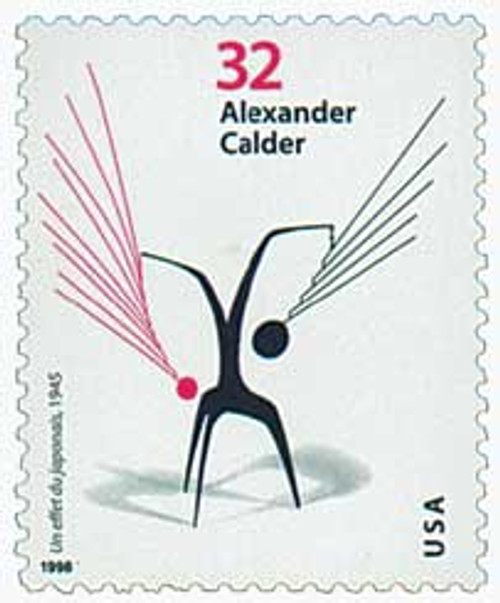
# 3198-3202 - 1998 32c Alexander Calder
1998 32¢ Alexander Calder
City: Washington, DC
Quantity: 80,000,000
Birth Of Alexander Calder

Alexander Calder was born on July 22, 1898, in Lawnton, Pennsylvania. There’s been some confusion over the years though, as members of his family suggest he was born one month later, on August 22.
Calder came from a family of artists – his father and grandfather produced numerous sculptures in Philadelphia and his mother was a portrait painter. Calder produced his first sculpture in 1902 when he was four years old.
Calder’s family moved to Arizona and later California, where he set up his first studio in the family basement. The family then moved to Philadelphia in 1909, where Calder briefly attended the Germantown Academy. They then moved to Croton-on-Hudson, New York, where Calder met his father’s friend Everett Shinn. Together they built gravity powered mechanical trains. During his teen years, the family moved back and forth between New York and California, but he ultimately graduated in San Francisco in 1915.

Calder’s parents didn’t want him to have to struggle as most artists did, so they encouraged him to go to college in another field. He had a talent for engineering since childhood, so he chose mechanical engineering and enrolled in the Stevens Institute of Technology in Hoboken, New Jersey. During his time in college, Calder trained at the Plattsburg Civilian Military Training Camp and joined the Student’s Army Training Corps.
After graduating in 1919, Calder worked as a hydraulic engineer and draughtsman for the New York Edison Company. He then worked as a mechanic on a passenger ship. During his travels, he saw beautiful scenery that made him decide to return to New York to become an artist.

Calder then enrolled in the Art Students League and found work at the National Police Gazette. Among his assignments was sketching the Ringling Brothers circus, a theme he would frequently revisit in his later artwork.
In 1926, Calder moved to Paris to study at the Académie de la Grande Chaumière. While there, he created a miniature-animated circus from wire, cork, and cloth that caught the attention of the artistic elite. Artist Marcel Duchamp called Calder’s moving art “mobiles” and the name stuck. Another artist, Jean Arp, gave his stationary sculptures the equally interesting name “stabiles.”

Although most of his work was of animals, Calder did some abstract sculptures. These were soon given their own unique term, “Watchama-Calders.” In later years, Calder’s work took on monumental sizes and can be seen in public buildings like John F. Kennedy Airport, and the Hart Senate Office Building. Calder died from a heart attack on November 11, 1976, shortly after opening a major retrospective show at the Whitney Museum in New York. He posthumously received the Presidential Medal of Freedom the following year.
Click here to view Calder’s works.
1998 32¢ Alexander Calder
City: Washington, DC
Quantity: 80,000,000
Birth Of Alexander Calder

Alexander Calder was born on July 22, 1898, in Lawnton, Pennsylvania. There’s been some confusion over the years though, as members of his family suggest he was born one month later, on August 22.
Calder came from a family of artists – his father and grandfather produced numerous sculptures in Philadelphia and his mother was a portrait painter. Calder produced his first sculpture in 1902 when he was four years old.
Calder’s family moved to Arizona and later California, where he set up his first studio in the family basement. The family then moved to Philadelphia in 1909, where Calder briefly attended the Germantown Academy. They then moved to Croton-on-Hudson, New York, where Calder met his father’s friend Everett Shinn. Together they built gravity powered mechanical trains. During his teen years, the family moved back and forth between New York and California, but he ultimately graduated in San Francisco in 1915.

Calder’s parents didn’t want him to have to struggle as most artists did, so they encouraged him to go to college in another field. He had a talent for engineering since childhood, so he chose mechanical engineering and enrolled in the Stevens Institute of Technology in Hoboken, New Jersey. During his time in college, Calder trained at the Plattsburg Civilian Military Training Camp and joined the Student’s Army Training Corps.
After graduating in 1919, Calder worked as a hydraulic engineer and draughtsman for the New York Edison Company. He then worked as a mechanic on a passenger ship. During his travels, he saw beautiful scenery that made him decide to return to New York to become an artist.

Calder then enrolled in the Art Students League and found work at the National Police Gazette. Among his assignments was sketching the Ringling Brothers circus, a theme he would frequently revisit in his later artwork.
In 1926, Calder moved to Paris to study at the Académie de la Grande Chaumière. While there, he created a miniature-animated circus from wire, cork, and cloth that caught the attention of the artistic elite. Artist Marcel Duchamp called Calder’s moving art “mobiles” and the name stuck. Another artist, Jean Arp, gave his stationary sculptures the equally interesting name “stabiles.”

Although most of his work was of animals, Calder did some abstract sculptures. These were soon given their own unique term, “Watchama-Calders.” In later years, Calder’s work took on monumental sizes and can be seen in public buildings like John F. Kennedy Airport, and the Hart Senate Office Building. Calder died from a heart attack on November 11, 1976, shortly after opening a major retrospective show at the Whitney Museum in New York. He posthumously received the Presidential Medal of Freedom the following year.
Click here to view Calder’s works.

















